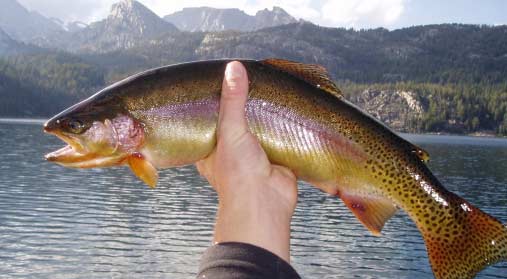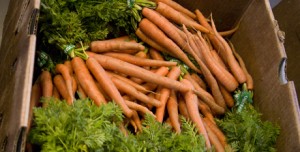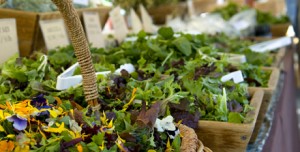The sun was setting behind the peaks of the Sierra Nevada. The sky was turning from blue to pink and purple and alpenglow turned the eastern peaks golden as I walked down to a serene lake in the backcountry of Kings Canyon National Park after a day of volunteer work with the National Park Service. Fish were surfacing on the water creating ripples across the entire plane of the lake. It looked like rain on a perfectly clear evening. I cast my line into the water. Right away my bait was taken and I reeled in a beautiful Golden Trout.

I don’t know if it was the beautiful backcountry setting or the fact that I had caught and prepared my own food, but dinner that night was one of the best meals I had ever eaten. There is something special about knowing the source our food comes from, and the more we know about our food sources the more we enjoy and appreciate them.
Our Food Comes From ???
Growing up in an agricultural community in Central Wisconsin, and knowing where our food came from, was a very important part of our family dinners. My great grandfather farmed for a living, and my grandfather worked on a cranberry marsh. We supported the local family farms as opposed to buying our beef, chicken, eggs, etc from the grocery store. It was not brought from miles away, treated with chemicals and pesticides, or grown and raised in factory farms.
 We were also avid fisherman and hunters and every winter our freezer was stocked with venison and walleye that we had either hunted ourselves or caught from our family lake in the Northwoods. At a young age I knew where I my food came from and I knew that it never traveled for hundreds of miles to get to my plate. I knew that it came from family friends and local farms or from the woods and lakes behind my house.
We were also avid fisherman and hunters and every winter our freezer was stocked with venison and walleye that we had either hunted ourselves or caught from our family lake in the Northwoods. At a young age I knew where I my food came from and I knew that it never traveled for hundreds of miles to get to my plate. I knew that it came from family friends and local farms or from the woods and lakes behind my house.
I once asked a 19 year old where his food came from and he replied, “from the grocery store.” I was very disturbed by his answer and I remembered what Aldo Leopold once said, “There are two spiritual dangers in not owning a farm. One is the danger of supposing that breakfast comes from the grocery, and the other that heat comes from the furnace.”
In the U.S., the average fruit or vegetable travels 1,500 miles from where it was grown to your dinner table.
 Too many people today do not know the source of their food. As factory farms take over and the family farm has almost gone extinct there has never been a more important time to show our youth the importance of buying locally and how we can help this ongoing problem. As outdoor educators in Southern California we stress in every lesson the importance of how we use our resources and a main issue concerning our resources is how far our food travels, where it comes from, and what it is treated with.
Too many people today do not know the source of their food. As factory farms take over and the family farm has almost gone extinct there has never been a more important time to show our youth the importance of buying locally and how we can help this ongoing problem. As outdoor educators in Southern California we stress in every lesson the importance of how we use our resources and a main issue concerning our resources is how far our food travels, where it comes from, and what it is treated with.
At High Trails, we encourage students to reduce their food waste and to appreciate what they have on their plates. There is a growing movement in the United States to prevent childhood obesity, eat healthier, and support local farmers. It has to start with educating young people in America about food and agriculture. While fast food corporations and other chain restaurants rake in the dollars and are cutting down the rainforest for more grazing land for their cattle, the local family owned farms that do not treat livestock with steroids and hormones, or use pesticides on produce and other crops are struggling to feed their families. I can think of no better time to place more importance on the source of our food in this country.
Farm To School
 Farm to School is a program that can help show young people in America the importance of buying locally and eating healthy. According to their website, “Farm to School is broadly defined as a program that connects schools (K-12) and local farms with the objectives of serving healthy meals in school cafeterias, improving student nutrition, providing agriculture, health and nutrition education opportunities, and supporting local and regional farmers.”
Farm to School is a program that can help show young people in America the importance of buying locally and eating healthy. According to their website, “Farm to School is broadly defined as a program that connects schools (K-12) and local farms with the objectives of serving healthy meals in school cafeterias, improving student nutrition, providing agriculture, health and nutrition education opportunities, and supporting local and regional farmers.”
The State of California is largely based on agriculture and with it’s nearly year-round growing season it is easy for Californians to by fresh local food year round. The California Farm to School program has over 1000 programs across the state educating young people about the importance of eating healthy and buying locally grown food.
For every dollar spent on local foods in schools, one to three dollars circulate in the local economy
 There is much we can do in Southern California such as planting gardens, visiting local farmers markets, and taking field trips to local farms. The Farm to School program can provide our California schools a step in the right direction to supporting our local farmers, fighting childhood obesity, reducing our fossil fuel emissions, and offering young people motivation in a fun and exciting way to eating right and living a healthy life.
There is much we can do in Southern California such as planting gardens, visiting local farmers markets, and taking field trips to local farms. The Farm to School program can provide our California schools a step in the right direction to supporting our local farmers, fighting childhood obesity, reducing our fossil fuel emissions, and offering young people motivation in a fun and exciting way to eating right and living a healthy life.
For more information click here.
At High Trails Outdoor Science School, we literally force our instructors to write about elementary outdoor education, teaching outside, learning outside, our dirty classroom (the forest…gosh), environmental science, outdoor science, and all other tree hugging student and kid loving things that keep us engaged, passionate, driven, loving our job, digging our life, and spreading the word to anyone whose attention we can hold for long enough to actually make it through reading this entire sentence. Whew…. www.dirtyclassroom.com

Comments are closed.